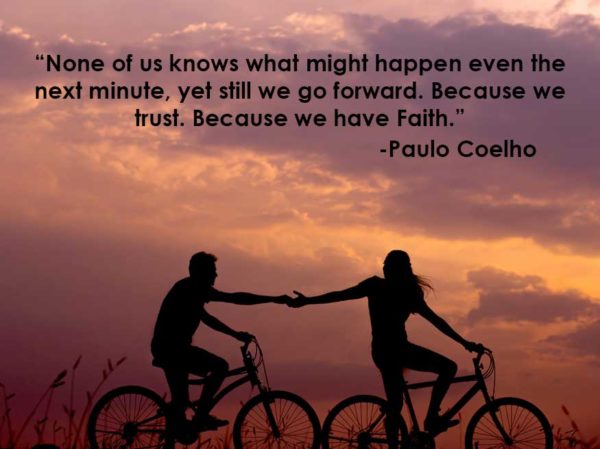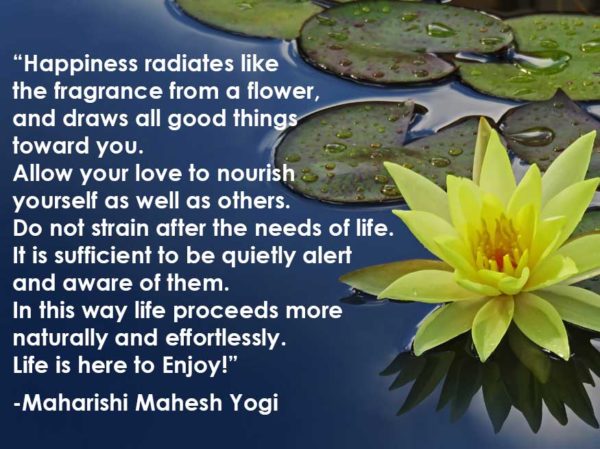 A group taking a yoga teacher training often starts out as strangers and ends with many friendships being forged over the time together. Shared learning, vulnerability, and intense curiosity fuel the growth of those relationships. So does trust and clear communication. In this article, we’ll dive into how these last two elements can be seamlessly implemented into your training for more harmony and efficiency. And, these insights will help you better navigate the terrain if you find yourself as a participant in one.
A group taking a yoga teacher training often starts out as strangers and ends with many friendships being forged over the time together. Shared learning, vulnerability, and intense curiosity fuel the growth of those relationships. So does trust and clear communication. In this article, we’ll dive into how these last two elements can be seamlessly implemented into your training for more harmony and efficiency. And, these insights will help you better navigate the terrain if you find yourself as a participant in one.
I’m someone who loves ongoing learning and often find myself in the student role. The first day of a recent teacher training was a beautiful, sunny, 70-degree morning. I arrived at the studio to find a group of eight outside the closed doors. Phew! My first thought was that I wasn’t late! It was 8:25 am with a start time of 8:30 am.
Everyone became a bit concerned as 8:30 rolled around and there was still no sign of the instructor or the other 12 people enrolled in the course. We called the teacher. We left a voicemail. We sent a text. No response.
Finally, another trainee arrived and informed us that the first day of the class actually started at 9 am. We were all confused.
“How did you know this information?” we inquired.
“It was on the welcome email you received when you were accepted into the course,” she responded.
I received that email over 7 months prior to the start of the training. For others, that was further back in time. This lack of clear communication affected our relationship with the teacher, even though many had not met the instructor in person yet. This incident could have been easily avoided. We’ll show you how below, as well as share other great ways to build trust with your group in any teacher training setting.
THE POWER OF TRUST
Relationships grow one step at a time. Two people, or a group, form agreements based on where they are and where they want to go. Trust is then built as each party involved holds to their side of the agreement. In your friendships, this could manifest as a decision to meet for lunch at 12:30 pm. When both arrive on time, confidence between the two increases. Similarly, a teacher training is comprised of many agreements. The instructor has described what learning will be offered and enrolled students are ready to engage in such learning. As each person speaks honestly and takes responsibility for their actions along the way, a stronger bond forms within the group.
The Yoga Sutras, written by Patanjali, outline a path to experience a blissful state of consciousness. The first step on this journey is to live by five basic guiding principles in relationships. These ethical suggestions are called yamas. Satya–the Sanskrit term that translates into being honest with ourselves and others–is the second yama.
Now, if you look at the confusion experienced on the first morning of our yoga teacher training, the instructor did not purposely deceive us. They were not being manipulative or deceptive. They simply did not reinforce important logistical information in the emails sent just before the start of the training.
Said another way, the way in which you communicate with others affects the level of trust between individuals. It can reinforce a sense of integrity between people, and prevent unwanted conflict. This is why we suggest using the communication tools below to enhance truth and build confidence in your relationships.

Photo Credit: Everton Vila
RELATIONSHIPS WITH TIME
Teacher trainings are comprised of a wide variety of individuals, with diverse backgrounds and interests. You can have engineers, speech pathologists, cardiac nurses, moms, kickboxers, and recent college grads (from any number of majors). In their everyday lives, they have a relationship with time. Their jobs, classes, and families all function–on some level–within the set 24-hours of each day. In fact, time is one amazing factor that allows us to coordinate and collaborate as a society.
The importance of time also exists within the yoga world. You have set classes on a weekly schedule. You invite new students to arrive early to fill out the necessary paperwork. And, you create class structures to fit within the allotted time space on any given schedule.
How you utilize time throughout your workshop or training sets the tone for the entire experience. You become a model of how yoga teachers can use time efficiently in their own businesses to build trust with their students. Managing time well–and communicating your expectations about time during your time together–can also show great respect for all involved in the training.
Here are some great ways to honor your time and theirs:
(1) HIGHLIGHT IMPORTANT INFORMATION
Before a training begins, there is lots of information you need to share with participants. This includes, but is not limited to:
- Dates and times of the training
- Expectations of the course
- Financial balances, including when and how to pay them
- Topics that will be covered
- Style and frequency of yoga that will be practiced
- How to connect with other participants
- Studio logistics (like bathrooms, cleanliness, and food storage)
- Transportation details in, out, and around the area
- Accommodation options, and
- Local hot spots to enjoy while in the area
Some of this information might permanently remain on your website as a point of reference. Other components might be sent out in a series of emails–from the time someone expresses interest in the course to within 24-hours of the actual start of the training. You might even answer some of these concerns over the phone.
In any case, you can build trust in this process by highlighting important information along the way. This is especially true for any changes or irregularities. For example, the course I mentioned above started daily at 8:30 am. This information was also posted on the website. Yet, the only day with a different start time was the first day of class.
You can further add to the clarity for the group by sending out this really important information just before the training begins (even if this information has been mentioned previously). People have full lives, and any details sent out in the past could have potentially gotten lost in the fray.

Photo Credit: Casey Brooke Photography
(2) START ON TIME
Beginnings matter as they set the tone for the experience, and each new moment is a chance to begin anew. In a teacher training, there are multiple times a day to start over. This includes not only the first few minutes of each morning, but after each break, each segment, and after lunch.
Through your leadership of timeliness, you encourage students to cultivate tapas. While tapas is often referred to as “building heat or stoking an inner fire,” it’s also a practice of discipline. If you instruct the group to be back by a certain time, but you fail to start on time repeatedly, then it creates a lackadaisical environment. It also weakens your ability to regain control of the group. This can weaken commitment in those who tend to run late and frustrate those who do honor the scheduled time to start.
Here are three ways you can start on time to build trust within the group:
Outline your expectations from the get-go
When my husband and I used to travel the country leading workshops, we had a one-page agreement that each participant signed the first day of class. This document explained expectations for the group. Essentially, it gave everyone tips on how to enhance the experience for themselves and others. We went through each bullet point collectively. Then, each person signed a copy and handed it in. We rarely had any issues with breach of conduct, and having this written document ensured we were all on the same page.
Create valuable filler time
Begin each new session with 5-10 minutes of valuable filler time. Tell a relevant story or share pertinent yogic insights that increase the learning for those who arrived on time. You might even open up the room for a quick Q&A session. This buffer also gives a bit of leeway for those who are late.

Photo Credit: Diane Nicole Photography
(3) END ON TIME
As with multiple starts throughout a training, there are also multiple endings. And endings are very important. They help students evaluate and bring meaning to the experience. Endings also tend to be the most memorable part of an interaction.
Let’s say you are passionately diving into the history of yoga. You love the topic and share it in detail with your group. Somehow along the way you lose track of time. And, in your excitement about yoga, you fail to notice the glossy eyes and slumped posture of your students as they’ve gone into a pre-lunchtime coma. 30-minutes past your lunch break, you finish the lecture and dismiss the group.
No matter how great your presentation, their hunger will likely have overtaken their ability to focus and absorb information. Instead, allow frequent breaks to prevent mental overload. And, when you end each segment on time, you invite them to maintain a more energetic outlook on the material.
Here are some simple ways to make certain you end on time:
Face the clock
While this might seem like common sense, I’ve seen many instructors position themselves in a way that they could not easily track the time. Face the clock when teaching, especially during lecture portions of a training. Then you can pace yourself in a way that keeps you on schedule.
Delegate a time-keeper
As stated previously, each teacher training contains numerous personality types within the group. Among them will likely be someone who loves to be on time. Ask if they will be willing to keep you on track throughout the course and have them give you a head’s up 10 minutes prior to the end of a teaching segment.
When I lead a training, I have someone tap a singing bowl to notify me, and the group, a break is just around the corner. This helps me end the segment in a cohesive manner, and prevents students from getting restless.
(4) PLAN TIMES TO EAT
Teacher trainings are very active experiences in which you practice yoga asanas and demonstrate full sequences every day. In order for students to maximize their learning capability, it’s essential they stay hydrated and nourished. Help them plan when and what to eat. This includes telling them when they will be active and when they will be more sedentary, listening to lectures.
For example, one evening our teacher informed us that we would be doing inversions in the morning. As a result, many people ate a very light (and early) breakfast, while many others did not eat at all. To our surprise, plans changed, and we had two hours of lecture before starting the inversion practice. Unfortunately, several people were hungry and ate on the morning break to prevent getting hangry. This caused them to forego the upside-down work.
You can prevent as a leader this through your clear communication. And, if the information is not being provided by the teacher, then feel free to ask questions as the student. Get as much clarity as you need to make the best of your experience in the training. Taking care of yourself with food and water along the way are two great ways to do this!

Photo Credit: Elijah O’Donell
(5) NOTIFY THE GROUP OF ANY CHANGES
Participants understand that things change. There are lots of topics to cover in teacher trainings, and you want to have some flexibility built into your program to accommodate the unique needs and desires of the group. For example, an interesting Q&A session can turn into a deep discussion about yoga philosophy. This may initially take away from another topic in the moment, but you likely have room to squeeze in that information later.
That being said, share your thoughts about these changes with the group. Tell the trainees about the modifications to the schedule. Expressing these small changes in the upcoming hours and days of the workshop can give students an idea of how to eat and move in relation to those changes. This keeps you in charge of your class. This level of transparency continues to build trust between you and the group, and helps keep everyone at their best along the way.

Photo Credit: David Clode
PUTTING IT TOGETHER
Trust is an essential element with a group at a teacher training. It fosters understanding and respect among all involved. And it leads to higher engagement throughout the course. One of the easiest ways to build trust is to use time wisely. You can do this by highlighting important information to the group, starting on time, ending on time, planning when to eat, and notifying everyone of changes to the syllabus. It has been my experience that when I follow these guidelines, my workshops run more smoothly and efficiently.
How do you utilize clear communication and time management at your events? Please leave your thoughts below!








Leave A Comment